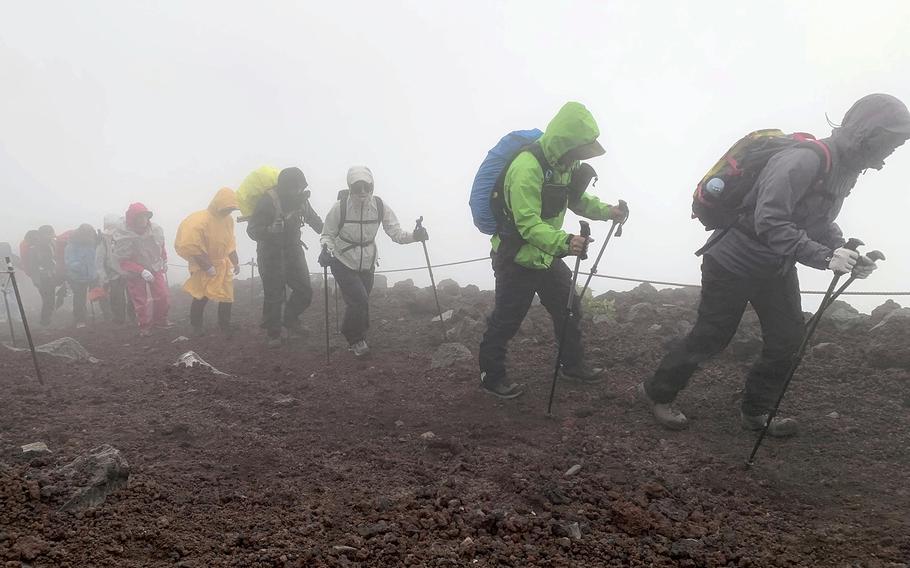
Climbers head to the summit of Mt. Fuji in bad weather. (The Japan News)
SHIZUOKA, Japan — A series of fatal accidents have occurred along climbing routes on the Shizuoka Prefecture side of Mt. Fuji within just two days since its Fujinomiya, Subashiri and Gotemba trails opened Wednesday.
Three people were confirmed to have died as of 6 p.m. local time Thursday. By contrast, the death toll in each of the five previous seasons was somewhere between zero and two.
Local police urged climbers to consider the weather conditions and their physical fitness and choose wisely when deciding whether or not to climb.
The Shizuoka prefectural police said they received an emergency call at around 2:05 p.m. Wednesday from a climber near Kengamine peak - the summit of Mt. Fuji – saying that someone had fallen.
An elderly man was found lying in a spot off the trail and was later confirmed dead. The prefectural police are investigating the cause of the man’s fall.
On Wednesday evening, a 77-year-old man from Komae, Tokyo, was found unconscious on the Gotemba Trail and confirmed dead the following day. An elderly man was also found lying on the Fujinomiya Trail early on Thursday morning and later confirmed dead. The causes of both deaths are still under investigation.
On the same trail, a 29-year-old woman from Komae was rescued Wednesday after apparently developing hypothermia.
According to the owner of a mountain lodge on the Subashiri Trail, it was raining, windy and sometimes foggy on both days.
“Mt. Fuji is a mountain for climbing rather than sightseeing, so first-time climbers should never push themselves too hard,” the owner said.
Be fully prepared
The number of accident victims on Mt. Fuji during the season has returned to the pre-pandemic level, according to the prefectural police’s community police affairs section. Over the past five years, between zero to two fatal accidents were reported per season, and three deaths in the first two days after opening is “unusual,” the section said. It believes that the bad weather near the summit may have contributed to this.
The section said climbers should be fully equipped with warm clothes and dedicated climbing shoes, as well as a flashlight and smartphone battery charger, to protect themselves from getting lost or having an accident. They also urged climbers to rest in a lodge rather than climbing during the night.
Climbing in bad weather increases the risk of accidents and distress, and it also takes time for those who encounter trouble to be rescued.
“Many visitors come from far away to climb Mt. Fuji. But it is always important to check the weather and make the choice not to climb if necessary,” said one police official.
Changeable weather conditions
“The cardinal rule is to only climb when conditions are good,” Japan Mountain Guides Association director Shunji Takekawa said.
In the first half of July, Mt. Fuji still has many stormy days due to the rainy season, and as the elevation increases, the temperature drops and winds become stronger, he said. In some places, wind speeds can reach up to 25 meters per second in bad weather.
“Mt. Fuji is very special because it is the highest mountain in Japan. The weather is fickle, and the environment can change in unimaginable ways,” Takekawa said. “It’s important to decide whether or not to climb based on the weather conditions and your own physical strength and fitness.”